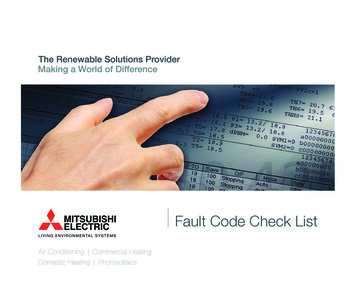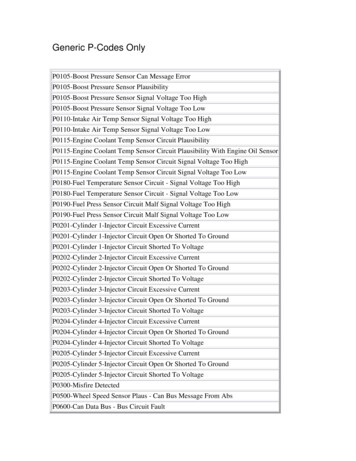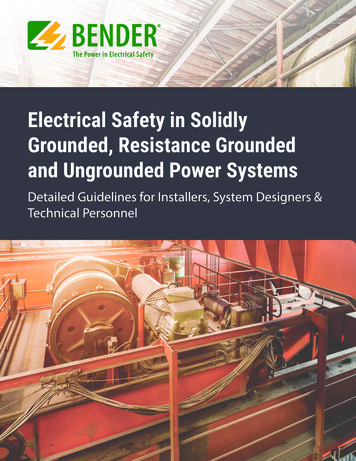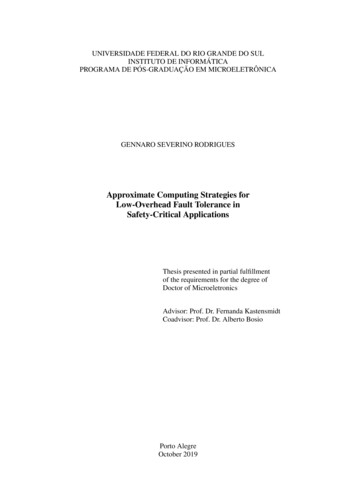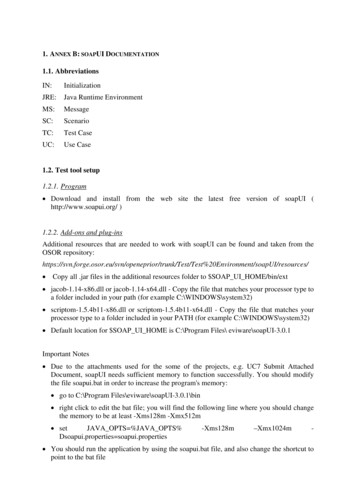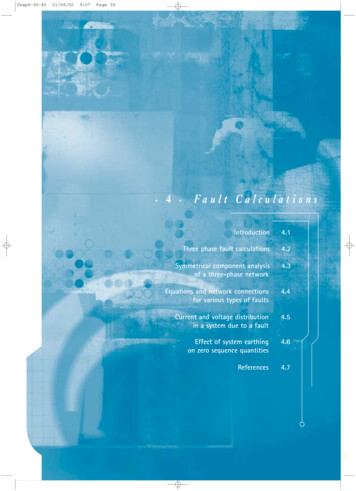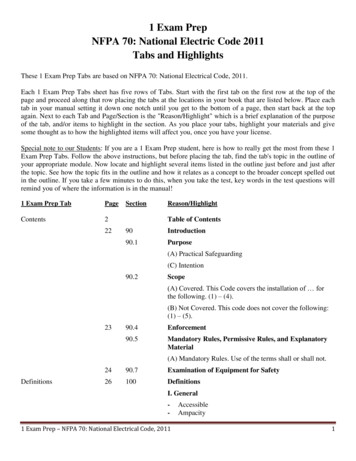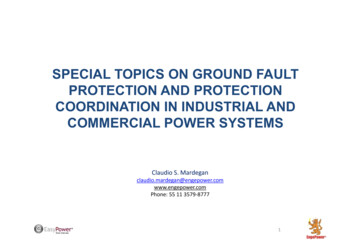
Transcription
SPECIAL TOPICS ON GROUND FAULTPROTECTION AND PROTECTIONCOORDINATION IN INDUSTRIAL ANDCOMMERCIAL POWER SYSTEMSClaudio S. r.comPhone: 55 11 3579-87771
Claudio S. Mardegan – Is a Senior Member (2013) of the IEEE. He is an ElectricalPower System Engineer graduating in 1980 from the Itajuba s Federal University(UNIFEI), in Brazil. He is a Director of the EngePower Company. He is theauthor of the book “Proteção e Seletividade em Sistemas Elétricos Industriais” (Protectionand Coordination in Electrical Power Systems). He is also the co-author of the Guide for LVand MV, Brazilian Standards NBR-5410, NBR-14039. He is consulting engineer forBrazilian and multinational companies and instructor of protection training, harmonictraining and substation training . He has written over 15 papers on power system analysis.Mr. Mardegan participates in the Generator Grounding, Surge Protecttion, Forensics, DC,3003-series and 3004-series working groups. He is chair of 3004.8 (Ground Fault Protection)and 3004.13 (Overcurrent Coordination). He has extensive experience in design, assembling,commissioning, maintenance, consulting and power system analysis.2
AbstractThis presentation intends to show some special topics on Ground Fault Protection (GFP)and Protection Coordination.Index1Ground Fault Current (Bolted and Arcing Fault / Calculated and Actual Value)2The importance of the adequate fault-current value for system protection andcoordination3System behavior as function of system grounding4Escalation of single-phase arcing faults5Types of coordination6Coordination Time Interval (CTI) determination7Where to apply CTI – general rule and particularities8Overcurrent relays - optimized setting9Phase protection as back of ground single line-to-ground protection10Coordination of voltage relays with overcurrent relays3
11GROUND FAULT CURRENT1.1 – Bolted Single line-to-ground Fault1.2 – Bolted line-to-ground fault for solidly grounded systems1.3 – Single-phase arcing fault1.4 – Generator Special Issues - Single line-to-ground Fault in Islanding Operation1.5 - Generator Special Issues - Single line-to-ground Fault in Parallel Operation1.6 – Generator Special Issues – Avoid mixing different system grounding types4
11.1 - Bolted Single Line-to-Ground Fault (ISLGBF)a (L1)b (L2)c (L3)ZF 0Conditions: Va 0 and Ib 0; Ic 05
11.2- Bolted Single Line-to-Ground Faultfor Solidly Grounded SystemsFor solidly grounded systems supplied by delta-wye transformers, ZG is negligible withrespect to Z0. Meanwhile, Z0 equals Z1 and Z2. Thus,Z1 Z2 Z0 ZG6
1.3 - Single-Phase Arcing Fault1Arcing Fault Calculation based on IEEE Std 1584 is explicitly valid for three-phase arcingfault. So, is not valid for line-to-ground arcing fault.Usually,Some papers use:0.38 x IBOLTED FAULT (Dunki-Jacobs)(0.47 to 0.52) x IBOLTED FAULT (Gammon & Matthews)For Protection Engineer the most import is to provide a setting lower than theactual value. Normally a value of 35% of bolted fault will solve most of thesystems.7
1.4 – Generator Special Issues - Single line-to-ground Fault inIslanding OperationConsider the one-line diagram presented below.Assumptions:GeneratorX”d 12.97%X’d 18.50%X0 3.07%X2 X”dX/R 26.1Transformer TX-1Z0 0.85xZ1X/R 16.1804Transformer TX-2Z0 Z1X/R 8.581
1.4 – Generator Special Issues - Single line-to-ground Fault inIslanding Operation1Conversion of the impedances to per unit values to the 100 MVA base. . .(15) 0.0667 86.19 (16.1804) 0.7160 86.46 (8.5) 2.416 83.29 5.6861 90 . 0.2179 0 5.6903 87.81 Z2G 5.6903 87.81 Z0G 1.3459 87.81 9
1.4 – Generator Special Issues - Single line-to-ground Fault inIslanding OperationSequence nceZ2SZ1TX-2 Z2TX-11ZeroSequenceZ2GZ0S Z0TX-1Z0GZ2TX-2Thevenin Equivalent ImpedancesZ1EQ Z1GZ2EQ Z2GZ0EQ Z0GZ1EQ 5.6903 87.81 Z2EQ 5.6903 87.81 Z0EQ 1.3459 87.81 10
1.4 – Generator Special Issues - Single line-to-ground Fault inIslanding OperationFault Sequence Circuit.Positive SequenceZ1EQNegative SequenceZ2EQEZero SequenceZ0EQI0 3 1000003 0.483 0.2351 87.81 120281 28352111
1.4 – Generator Special Issues - Single line-to-ground Fault inIslanding OperationSimulations Results.121
1.5 – Generator Special Issues - Single line-to-ground Fault inParallel OperationSequence nceZ2SZ1TX-2 Z2TX-1ZeroSequenceZ2GZ0S Z0TX-1Z2TX-2Thevenin Equivalent ImpedancesZ1EQ (Z1S Z1TX-1 Z1TX-2) // Z1GZ2EQ (Z2S Z2TX-1 Z2TX-2) // Z2GZ0EQ Z0G13Z0G1
1.5 – Generator Special Issues - Single line-to-ground Fault inParallel OperationFault Sequence Circuit.Positive SequenceIa1 SZ1SEZ1TX-1 Z1TX-2Negative SequenceIa2 SZ2SZ2TX-1 Z2TX-2Z1GZ2GIa1 GIa2 GZero SequenceZ0GI0Z1EQEZ2EQZ0EQI0141
1.5 – Generator Special Issues - Single line-to-ground Fault inParallel OperationFault Sequence Impedances.(Z1S Z1TX-1 Z1TX-2) 3.1978 84.06 Z1G 5.6903 87.81 Z1EQ 2.0483 85.41 (Z2S Z2TX-1 Z2TX-2) 3.1978 84.06 Z2G 5.6903 87.81 Z2EQ 2.0483 85.41 Z0G 1.3469 87.81 Z0EQ 1.3469 87.81 3 66301151
1.5 – Generator Special Issues - Single line-to-ground Fault inParallel OperationTotal Fault Current. 3 1 66301Current Contributions - System Contribution 0 0.11769 84.65 0.23538 84.65 0.11769 84.65 28311.7 84.65 Current Contributions - Generator Contribution 0.06614 88.4 0.1838 86.00 0.06614 88.4 38002 87 0.31595 87 16
1.5 – Generator Special Issues - Single line-to-ground Fault inParallel OperationSimulation Results.171
1.5 – Generator Special Issues - Single line-to-ground Fault inParallel OperationSimulationsBus Total FaultCalculatedSimulated66301 A66301 A28312 A28312 ACurrent ContributionsSystem ContributionPositive SequenceNegative SequenceGenerator Contribution38002 A38002 APositive SequenceNegative SequenceZero Sequence181
1.5 – Generator Special Issues - Single line-to-ground Fault inParallel OperationConclusionsWhen connecting utility and generator in parallel with the utility, for a ground fault atgenerator s terminals:a) The ground fault current may be greater than the three-phase short circuit current.b) The ground fault current with generator operating in parallel with the utility maybe greater than the single line-to-ground fault of generator in island operation.c) The current in the generator neutral for the parallel operation between generatorand utility is greater than single line-to-ground fault current for the condition ofgenerator island operation.d) Engineer has to be aware when sizing neutral conductors for generators.e) Protection Engineer has to be aware with current they are taking into accountwhen setting ground elements.SLD 191
1.6 – Generator Special Issues – Avoid Mixing Different SystemGrounding TypeThe example below shows us why we shall not mix different types of systemgrounding.SLD 201
1.6 – Generator Special Issues – Never Mix Different SystemGrounding TypeLine-to-ground FaultOnly Utility1Utility in Parallel with GeneratorAs showed above the line-to-ground current increases; in this case more than 10 times.SLD 21
1.6 – Generator Special Issues – Never Mix Different SystemGrounding TypeThe reason why this happens is presented in sequence impedance circuit below.Positive SequenceIa1 SZ1TX-1Z1SENegative SequenceIa2 SZ2TX-1Z2SZero SequenceIa0 S3ZGZ0TX-1Z1GZ2GZ0GIa1 GIa2 GIa0 GI0The reason for the increase of current is because the grounding current limitingresistor is in parallel with generator zero sequence impedance which is almostalways much smaller than resistor.SLD 221
22IMPORTANCE OF USING THE CORRECT VALUE OF FAULT CURRENTOvercurrent Protection Coordination has a general rule : Coordination is performed atshort circuit currents.SLD 23
22IMPORTANCE OF USING THE CORRECT VALUE OF FAULT CURRENTWhen using inverse time relays :If you use a calculated short circuit current value (10174) higher than the actual value(9150 A) the relay is going to take longer to trip. This means more damage and moretime to return system to operation.SLD 24
22IMPORTANCE OF USING THE CORRECT VALUE OF FAULT CURRENTWhen using inverse time relays :If you use a calculated short circuit current value (10174 A) lower than the actual value(11161A) the relay may miscoordinate with the downstream relay.SLD 25
Why is so important to consider the single line-to-groundarcing fault current in the ground coordination ?2As a general rule the TCI (Time Coordination Interval) is appliedon the TCCs at the Bolted Short Circuit Value (there someexceptions). What happens if an Arcing Ground Fault occurs ?Inverse Time ElementsRelayTrip for Bolted Fault :0.400 sTrip for Arcing Fault :0.698 sDefinite Time ElementsTrip for Bolted Fault :0.400 s26Trip for Arcing FaultSLD:0.400s
33SYSTEM BEHAVIOR AS FUNCTION OF SYSTEM GROUNDINGElectrical Power System voltage are becoming higher in the last years because theconsumed energy are increasing and the industrial plants are also becoming bigger(more cable lengths).Normally, the Project Engineer may choose a LRG, a HRG or even a HHRG as a way todetermine the system grounding. But, the system may have an unexpectable behavior.The example prepared in the next slide shows a single-line diagram based on a realcase of a paper mill plant in Brazil.The threshold of a system be considered grounded or not is defined by system straycapacitances. In terms of current the relationship between our neutral resistor current(IR) and stray capacitances current (IC0) is given by the below equation: 3SLD 27
3System Grounding TypeDetermines System BehaviorNormally, you may choose a LRG, a HRG or even a HHRG as a way todetermine the system grounding. But, the system may have anunexpectable behavior.SLD 28
3System Grounding TypeDetermines System BehaviorThe total capacitance at this level of voltage (34.5 kV) is given by:6.69240 0.109200.054556.85615As can be seen, the 3IC0 is greater than the resistor current. Thismeans that this system will have a behavior of an ungrounded systemwhen an unbalanced condition happens. At least a 200 A resistor isrequired.The Project Engineer has to take into account, protect the cable shieldswhen a ground fault occurs, but also have to take care when sizing theresistor short time amps for not be less than 3IC0.SLD 29
44ESCALATION OF SINGLE-PHASE ARCING FAULTSThere are few papers about single phase arcing fault escalation. Mr. DunkiJacobs s paper is one of these.Low Voltage SystemsIn low voltage switchgears and motor control centers (MCCs), bus bars are notnormally insulated and in these situations there are real possibilities of arcingground fault escalation into a phase-to-phase fault or three-phase fault.Medium Voltage Systems from 2.4 kV to 7.2 kVWhen the bus bars are insulated at medium-voltage levels from 2.4 kV to 7.2kV, the probability of escalation is low. The greatest number of cases of arcingground-fault escalation are when the bus bars are uninsulated.Medium Voltage Systems from 13.8 kV to 34.5 kVThe switchgears bus bars in these 13.8–kV to 34.5-kV levels are normallyinsulated and the probability of the arcing ground fault escalating into a phaseto-phase fault and into a three-phase fault is low. However, in solidly groundedaerial-line distribution systems, escalation occurs in 1 to 2 cycles [6]SLD 30
55TYPES OF COORDINATIONThree main types of coordination are usually used in Protection Coordination Studies:; Chronological Coordination; Current Coordination; ZSI (Zone Selective Interlocking) CoordinationChronological CoordinationIs that one where the time interval coordination is applied between the downstreamand upstream protective device.t [s]90 A2I cc 1156 AI 90 A210.50 sΔt 0.25s0.25 s10,25 s90 AI cc 1156 A1156 AI [A]SLD 31
55TYPES OF COORDINATIONCurrent CoordinationWhen a big impedance value exist between the downstream and upstream protectivedevice current coordination may be applied. The advantage of this type of coordinationis that instantaneous element can be set.t [s]0.48 kV CURRENTS ARE REFERRED TO 13.8 kV ON THE TCCCurrent coordination reset the time of thechronological coordination. The upstreamprotective device, above device 2, instead ofstarting coordination on the time of 0.5 s,will start on 0.04 s90 AI SC-A 1156 AI”SC-A 1571 AI SC-B 14643 AI”SC-B 22282 A22I 90 APOINT BT11500 kVAZ% 513.8-0.48 kV10.50 st 0.25s0.25 s10,25 sPOINT A0.04 s90 AI SC 33242 AI”SC 45175 AI [A]1156 A 1571 A 14643 A 22282 AISC atPOINT AISC atPOINT BSLD 32
55TYPES OF COORDINATIONZone Selective Interlocking (ZSI)I I t CBFt CBF32BZSI is applied between the downstream andupstream protective device with the maintarget of reducing trip time delay.SignalsConventionLEGENDAI t CBF1TRIPBLOCKINGBLOQUEIOBREAK FAILUREASLD 33
6COCOORDINATION TIME INTERVAL (CTI) DETERMINATION6CTI is fundamental to guarantee that downstream protective device is going to tripbefore the upstream protective device.It is determination depends on many factors:;;;;;CT errorsCircuit breaker interrupting timeProtective device pickup errorProtective device delay errorProtective devices time x current characteristicsIEEE Std 242-2001TM - Buff Book suggested CTI table is presented below:SLD 34
6COCOORDINATION TIME INTERVAL (CTI) DETERMINATION6The CS used by IEEE Std 242-2001 means Clear Space between curves. During 34 yearsworking with these types of protective devices, most of the manufacturers even withthe downstream breaker curve touching the upstream breaker curve may ensure fullcoordination. So, my suggestion is always consult the respective manufacturer. Some ofthem have specific software that automatically tells you if you have coordination ornot. You will have a big issue if the breakers are from different manufacturers.Curves are touchingthemselves and forthis specific breakerthe manufacturerensuresfullcoordination.SLD 35
7COWHERE TO APPLY CTI GENERAL RULE AND PARTICULARITIES7Main Rule – CTI is applied at short-circuit current value.2t12Δt1I ccI ccISLD 36
7COWHERE TO APPLY CTI GENERAL RULE AND PARTICULARITIES7Particularities – Two incoming feeders in parallel with one outgoing feeder.23I1tI223Δt1I cc I1 I21I ccI1 I2I cc I1 I2ISLD 37
7COWHERE TO APPLY CTI GENERAL RULE AND PARTICULARITIES7Particularities – Two incoming feeders in parallel with one outgoing feeder.Relay 1 - Curve : Very Inverse1200 A800 A2I13I2Ipk 100A1I cc I1 I2Ipk 100Atcc 0.25sI cc13.5( M 1) DT DT t M 113.5DT 0.25 Ipk 100A2000 t M Icc 2000 20Ipk 100(20 1) 0.3513.5Relay 2 - Curve : Very Inverset 13.5( M 1) DT DT t M 113.5DT 0.50 M Icc 1200 12Ipk 100(12 1) 0.4113.5Relay 3 - Curve : Very Inverset 13.5( M 1) DT DT t 13.5M 1DT 0.50 M Icc 800 8Ipk 100(8 1) 0.2613.5SLD 38
7COWHERE TO APPLY CTI GENERAL RULE AND PARTICULARITIES7Particularities – Two incoming feedersin parallel with one outgoing feeder.SLD 39
7COWHERE TO APPLY CTI GENERAL RULE AND PARTICULARITIES7Particularities – Line-to-line short circuit on secondary side of DY Transformer.1 0.583I CC 2φ 1 puBIn one of thethree phases ofprimary side willcirculate threephaseshortcircuit.1/ 32 1.161/ 3A3BCA1 / 3 0.58CtI12223 I L L SC I 3 PH SC I 3 PH SC33 22Δt1I cc2Icc2 φ1Icc2 φIcc3 φISLD 40
8COOVERCURRENT RELAYS – OPTIMIZED SETTINGS8Phase-Protective DevicesTime [s]3-PhaseArcing Fault123T4CTICoordination Time IntervalT3t 0.25sDevice 3 – Gain in timeDevice 2 – Gain in timeT2t 0.20sSingle Line-to-Ground Bolted FaultT1ISLGBFIarc3PHCurrent [A]SLD 41
8COOVERCURRENT RELAYS – OPTIMIZED SETTINGS8Ground-Protective DevicesTime [s]Iarc123T4CTICoordination Time IntervalT3t 0.25sDevice 3 – Gain in timeDevice 2 – Gain in timeT2t 0.20sSingle Line-to-Ground Bolted FaultT1IarcISLGBFCurrent [A]SLD 42
8COOVERCURRENT RELAYS – OPTIMIZED SETTINGS8Special care when optimizing settingsTimeInverse Time ElementUpstream Protective DeviceDefinite Time ElementCoordinationTime SCCurrentSLD 43
COPHASE PROTECTION AS BACKUP OF GROUND SINGLE LINE-TO-GROUND9PROTECTIONPhase-Protective Devices9Time [s]1-PH and 3-PHArcing Fault123T4CTICoordination Time IntervalT3t 0.25sDevice 3 – Gain in timeDevice 2 – Gain in timeT2t 0.20sSingle Line-to-Ground Bolted FaultT1ISLGBFIarc1PHIarc3PHCurrent [A]SLD 44
CO COORDINATION BETWEEN VOLTAGE AND OVERCURRENT ELEMENTS1010For single line-to-ground faults, when system grounding is not solidly grounded,voltage elements have to coordinate with overcurrent elements. The reason is becausewhen a line-to-ground fault happens in these systems, at the healthy phases thevoltage increases and may cause overvoltage elements to trip. This condition is evencritical for the operator s safety, because looking at alarm annunciator may think thatthe only problem he has it is an overvoltage and in fact the problem is a short circuit.Warning! Overvoltage elements can never be set instantaneous in impedancegrounded or insulated systems.Typical settings are:U 115% UnU Delay 3 sU 120% UnU Delay 2 sIf the system is solidly grounded the settings may be:U 115% UnU Delay 2 sU 120% UnU Delay 0.0 sSLD 45
THANKS !!!QUESTIONS?SLD 46
Claudio S. Mardegan claudio.mardegan@engepower.com www.engepower.com Phone: 55 11 3579-8777 SPECIAL TOPICS ON GROUND FAULT PROTECTION AND PROTECTION
